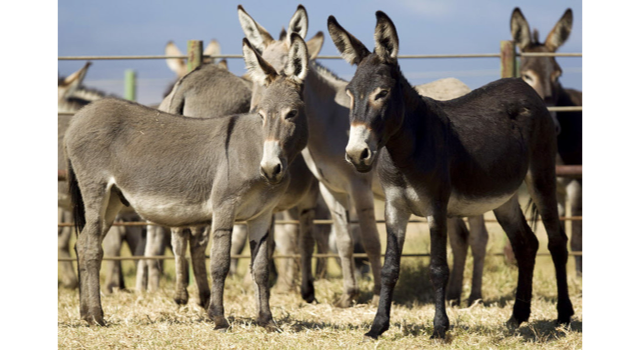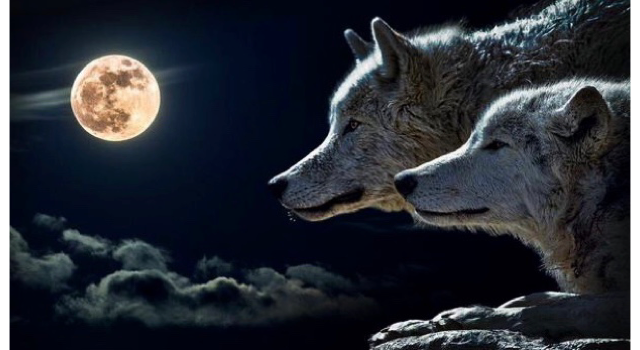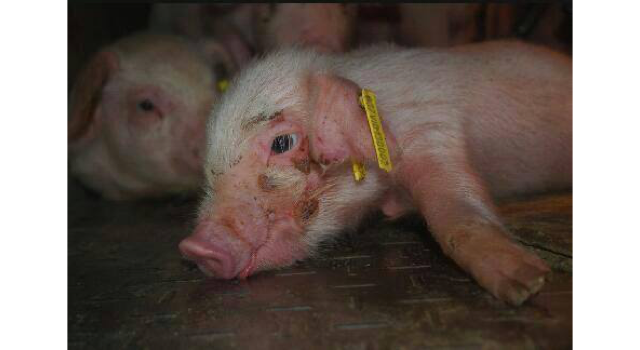Walrus In The Arctic Dies From Bird Flu. Researchers have confirmed the first known case…

More Than 30 Dead Pigs Were Rotting And Covered In Flies On UK Pig Farm.
On Viva!’s first visit to the now infamous Hogwood Farm it was nothing like the Fort Knox it is today – with its imposing high steel perimeter fencing and heavy-duty padlocks hung from every door.
In some ways it was unassuming, its industrial-sized units tucked behind a large farmhouse and gated entry point.
But the smell, the fetid stench of ammonia and excrement, that was the giveaway.
Under the cover of darkness, two lone investigators found themselves face-to-face with some of the most sickening scenes ever uncovered on a UK pig farm.
More than 30 dead pigs were recorded, rotting and covered in flies.
Hundreds of sows were found confined to barbaric farrowing crates, one heavily pregnant and struggling to make herself comfortable on the barren floor of her pen.
And thousands of young pigs in the fattening sheds all crammed together, looking for some form of entertainment as they trampled through piles of their own waste.
It was overwhelmingly claustrophobic and the boredom had led to grotesque cannibalism, an exceptionally rare and entirely unnatural behaviour for pigs.
Hogwood Farm was supplying Tesco, the UK’s third most popular supermarket according to YouGov, and certified by the Red Tractor assurance scheme.
Quite unbelievably, the most recognisable food standards organisation in the country was approving this hellhole.
Following multiple complaints to every stakeholder, including the Animal and Plant Health Agency, action was promised.
Yet reassurances from big business, the industry, and government alike meant nothing, as follow-up investigations in 2018 and 2019 went on to prove.
It seemed that powerful players in the food production system were more intent on hiding the truth than cleaning up their act.
Two years after the Viva! team first infiltrated Hogwood Farm, animals were filmed screeching in terror as workers ruthlessly kicked them and beat them with metal hand tools.
Although minor changes around the site were apparent, the vast majority of pigs remained enclosed in filthy overcrowded pens with little to no environmental enrichment, resulting in vices such as ear, tail, and flank biting.
One of the most distressing findings was a young pig, bitten and bullied by the others in her pen.
Covered in lacerations, she endured nearly 48 hours of brutal attacks before the farmer moved her to the gangway, swollen and sore.
Government standards insist sick and injured animals must be isolated in a hospital ward with soft bedding.
But not at Hogwood.
She was abandoned in the walkway, her wounds left untreated.
Finally, Tesco acted.
Red Tractor terminated Hogwood’s membership to their assurance scheme with immediate effect and Cranswick plc, one of Britain’s leading food producers, ceased supply indefinitely.
Tesco was left with no choice but to drop them and admit such acts of violence were, quite rightly, unacceptable.
( Lex Rigby, 19.10.2022 ) .. sentientmedia.org
Dead Piglets Were Piled High And Riddled With Maggots.
The first shed I entered was colossal, with more tightly packed pigs than it is possible to imagine.
I tried to step carefully through them but they swarmed towards me, keen to investigate my unfamiliar presence.
They nibbled at the shoe coverings I wore for biosecurity purposes and tugged for my attention.
They were inquisitive adolescents, about three months old and wide awake, despite the early hour.
In other sheds I found sick animals left abandoned in gangways.
Pig skulls, a jaw, and a hacked off lower leg, all left to rot in what looked like years’ worth of filth.
A dead, blackened, and bloated body of a pig being pushed and prodded by his cellmates, all covered in excreta.
And mothers giving birth onto cold, unforgiving concrete, locked inside farrowing crates with little room to move forwards or backward, let alone turn around.
In a skip outside, dead piglets were piled high and riddled with maggots.
( Juliet Gellatley, Viva!’s founder and director ) .. sentientmedia.org
Around 13,000 Donkeys Are Killed Every Day For Their Skin.
The illicit trade in donkey skins driven by China sees nearly five million animals killed each year and is a “ticking time bomb” for the spread of infectious diseases among humans, according to a new report.
It is estimated that about 13,000 donkeys are slaughtered every day for their skins around the world, equivalent to 4.8 million a year, which go on to be turned into ejiao, a traditional Chinese remedy.
Practitioners say, with no scientific evidence, that ejiao helps with everything from fatigue and boosting the immune system to the suppression of cancerous tumours.
Now, The Donkey Sanctuary, a British charity based in Devon, has warned that the booming but illegal trade risks spreading zoonotic diseases, infections that are capable of jumping from animals into humans, like the Covid-19 virus.
The market for donkey skin has boomed in recent years, with whole villages in Africa being wiped clean of the animals.
Much of the killing happens in countries like Kenya, Nigeria and Ghana, where the animals are slaughtered and skinned in horrific conditions.
The skins are then shipped to China, Hong Kong, Thailand and Vietnam before being turned into traditional remedies.
Testing carried out by researchers on 108 donkey skin samples from an abattoir in Kenya found 88 of them to be carrying Staphylococcus aureus bacteria, the leading cause of skin infections such as abscesses and boils.
The study said that 44 samples were positive for an antibiotic resistant strain of the germ, and three of the samples contained Panton-Valentine leukocidin, a cytotoxin known to cause invasive necrotising disease in humans.
( Will Brown, 14.11.2022 ) .. telegraph.co.uk
Captured Dolphins And Whales Abused And Forced To Perform For Financial Gain.
Miami Seaquarium, located in Miami, Florida, opened in 1955.
Over the decades of operation, the dolphinarium has been cited for numerous animal welfare issues relating to their captive dolphins.
At least 117 dolphins and whales have died under the facility’s care.
Lolita (also known as Tokitae) is the last surviving orca of the infamous Penn Cove captures of 1970.
After capture, she was shipped to the Miami Seaquarium where she still remains to this day.
Lolita has remained captive at the facility in the smallest orca tank in North America for over 52 years, and has not seen another orca in 42 years after her companion Hugo died in 1980.
Miami Seaquarium has been promising to build Lolita a new tank since 1978.
Despite Lolita being 20 feet long, her tank is only 80 feet across.
Her exposure to the sun and weather violates Section 3.103(3)(b) of the Animal Welfare Act.
Her tank is also 13 feet shorter than what is required by the Animal Welfare Act (Section 3.104).
While aquariums and marine parks will have you believe there is much to be learned from captive dolphin shows, the real education doesn’t begin until after the show’s over.
Forced to perform and interact with other mammals day after day, held in small, sterile enclosures and lacking the ability to escape from the public eye creates an escalating cycle of stress and exploitation for captive dolphins.
Depriving them of the vast open spaces and social bonds that they would normally have in the wild, and confining them to small concrete tanks to perform tricks for dead fish is highly unethical and inherently cruel for these complex marine mammals.
The diets of nine dolphins at Miami Seaquarium’s Dolphin Harbor were severely cut for the purposes of ensuring the animals performed better for guest interactions.
What they got instead were multiple aggressive incidents against trainers, and even members of the public.
These are the findings documented in an inspection report on the Miami Seaquarium by the U.S. Department of Agriculture (USDA) dated July 6, 2022.
According to the report:
* Diets for nine out of 12 dolphins were cut by a staggering 60%.
* Star, a 23 year-old female dolphin went from being fed approximately 12 pounds of food daily to four pounds daily.
* Aries, a 20 year-old male dolphin went from being fed 13 pounds of food daily to three pounds daily.
* The dolphins became emaciated, with prominent muscle wasting and palpable scapula and ribs.
* Gastrointestinal abnormalities amongst the dolphins began taking place, including multiple instances of excessive regurgitation.
Despite these concerning medical events, the Miami Seaquarium allegedly failed to provide direct and frequent communications regarding their animal health and well-being to the attending veterinarian.
( Cara Sands, 24.10.2022 ) .. dolphinproject.com
Animal Waste From Industrial Farms Poses A Public Health Risk.
Smithfield is the largest pig and pork meat producer in the world, with farms and other operations in the U.S., Europe, and Mexico.
The Socially Responsible Agriculture Project (SRAP) report, which compiles findings from three decades of public records spanning 1991 to 2021, ties the company’s animal feeding operations (also called CAFOs or factory farms) to an average of 25 spills per year, amounting to an average of 240,000 gallons of waste spilled annually.
The leaking of animal waste from industrial farms poses a threat to public health, polluting waterways that provide local communities with drinking water and sometimes contributing to algal blooms that can lead to massive die-offs of marine life.
“Public records clearly show that Smithfield’s Missouri CAFOs have been major polluters ever since they were built. It’s difficult to reconcile the staggering volume and frequency of spills with Smithfield’s purported commitment to responsible food production”, says Sherri Dugger, SRAP’s executive director.
In March 2022, Smithfield’s Somerset Farm was fined $18,000 for spilling 300,000 gallons of manure into local creeks, in addition to 200,000 gallons of spilled waste that did not make it off the farm.
( Jennifer Mishler, 02.05.2022 ) .. sentientmedia.org
Wild Animals Should Not Be Confined In Captive Environments.
On January 1, 2023, a lion killed a lioness at the Longleat Safari Park in Wiltshire, UK.
After the incident, visitors were diverted away from the lion enclosure in the early afternoon, and one visitor who was close to the enclosure said on social media that a wounded lioness was visible lying still on the ground.
Staff said the lioness died very quickly.
Only two weeks before, Tala and Sumi, two red panda cubs born last summer at the safari park, died when the temperature went below freezing.
Staff said the initial investigations indicated that their deaths were caused by hypothermia and weaning issues.
These had been born as part of the park’s captive breeding programme for endangered species, showing how ill-thought these programmes are by bringing into existence animals in environments not suitable for them.
Several similar incidents of tragic deaths have been recorded in UK zoos in the last few years.
Chris Lewis, Captivity Research Officer of the Born Free Foundation, said: “These incidents highlight one of the many reasons why these species should not be kept in captivity. These animals are denied the opportunity to choose their own mates, and lack the ability to escape aggressive interactions. Combine this with the unnatural social behaviour that is so common among wild animals that are confined in captive environments, and you have a recipe for these kinds of tragic consequences. Zoos cannot claim that their facilities are the safest place for these animals, while at the same time trying to justify the occurrence of such incidents as natural.”
( Jordi Casamitjana, 09.01.2023 ) .. veganfta.com
Birds Of Prey Shot, Poisoned Or Trapped In The UK By Game Bird Shooters.
The RSPB’s annual bird crime report found there were 108 cases of bird of prey persecution, notably in Dorset, Norfolk and Yorkshire.
The report found 71% of cases were related to land managed for game bird shooting.
But the RSPB said the numbers were only the tip of the iceberg.
It said many killings of birds of prey go undetected and unreported.
The annual survey included 41 shootings or attempted shootings, 32 poisonings and 18 trappings, along with illegal nest destruction.
A total of 91 birds were affected, including buzzards, red kites, peregrines, and goshawks, as well as a hen harrier, white-tailed eagle, golden eagle, sparrowhawks and a number of owls.
All birds of prey are protected by law but they can be seen as a threat to stocks of pheasants, partridge or grouse by those involved in game bird shooting.
Norfolk, Dorset and Yorkshire, which are popular with such shooting, recorded the highest number of incidents, with 13,12 and 10 cases respectively.
Five individuals, all gamekeepers, were prosecuted in 2021 for offences relating to bird of prey persecution.
There has been a surge in the detection of rat poison brodifacoum at well beyond lethal levels, suggesting a deliberate misuse to target birds of prey.
A rare white-tailed eagle was discovered in Dorset with seven times the lethal dose of brodifacoum.
A golden eagle was found poisoned, lying beside a dead hare laced with the same banned pesticide, on a grouse shooting estate in Scotland.
In Wales, RSPB officers assisted a police investigation into a poisoned red kite and a shot buzzard and found 18 toxic pesticides, many of which are banned, stored on a pheasant shooting estate.
A “mass grave” of at least 11 buzzards and four red kites was found down a well on a pheasant shoot in Wiltshire.
The data in the RSPB report clearly shows that raptor persecution remains at a sustained high level, especially in England, with over two thirds of the incidents connected to land managed for game bird shooting.
( BBC News, 15.11.2022 ) .. bbc.co.uk
Fires In Bolivia Are Set By Humans To Clear Land For Farmland Expansion.
When soy farms and cattle ranches clear land for expansion, they often use what is supposed to be a controlled burn.
Yet the resulting fires often grow out of control, and the damage is essentially irreparable, emitting large amounts of carbon into the atmosphere, but also threatening the survival of thousands of animal species and their food sources, breeding sites and shelter.
The smoke also hurts animals and humans, causing eye and lung damage as freshwater sources in the forest become contaminated by leaching ash.
Though it’s one of the largest tropical dry forests in South America and the world’s best preserved, the Chiquitano is rapidly being deforested for intensive farming operations, mostly soy and cattle.
Yet because it’s not as well-known or studied as the Amazon, most of the public is unaware of the looming danger.
The Chiquitano forest covers around 24 million hectares, nearly the size of the U.K., most of which is located in eastern Bolivia, covering more than half the territory of the country’s biggest state of Santa Cruz.
The Chiquitano is home to a wide diversity of plants, animals and geological formations, as well as Indigenous peoples with a huge cultural legacy.
Fires in Bolivia are almost always set by humans to clear land, primarily for farmland expansion, including animal farming and soy for livestock feed.
Around 70% of soy farmland in the region is controlled by only 2% of soy producers.
Most of the production is used to feed farmed animals, both in the country and abroad.
Between 2005 and 2019, on average, almost 80% of the total soybean production was exported.
Over a 20 year period, Bolivia has lost forests on a massive scale, placing it among the top 10 countries for global tree cover loss between 2001 and 2021.
The World Research Institute ranked Bolivia third for forest loss in tropical countries in 2021.
( Matilde Nuñez del Prado Alanes, 03.11.2022 ) .. sentientmedia.org
Avian Flu Is Killing Hundreds Of Thousands Of Wild Birds.
The planet is experiencing a new “Silent Spring” of wildlife destruction because so many wild birds have died from avian flu.
This is according to a leading scientist, who said the past year has seen the most significant and sudden loss of birds in decades.
James Pearce-Higgins, director of science at the British Trust for Ornithology, said: “The last time we experienced such large-scale and rapid losses of wild birds in the UK would be the impacts of DDT on birds of prey in the 1950s and 1960s associated with the Silent Spring narrative, or the widespread declines of farmland birds during the 1970s and 80s as a result of agricultural intensification.”
The Silent Spring narrative refers to the seminal 1962 book by Rachel Carson about how pesticides, particularly DDT, were killing birds.
DDT caused egg shells to become so thin that adults crushed them during incubation, leading to nest failure and the deaths of thousands of birds.
The World Organisation for Animal Health estimates that more than 50,000 wild birds have died of the highly pathogenic avian influenza H5N1 since October 2021, mainly in Europe and America.
But experts say this is likely to be a huge underestimate.
In the UK alone, numbers could be in the hundreds of thousands, although conservationists say the true impact is still unknown, and most are unwilling to speculate.
( Phoebe Weston, 23.12.2022 ) .. theguardian.com



This Post Has 0 Comments